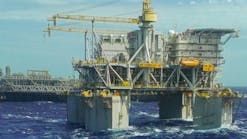Frank Hartley, Drilling and Production Editor
A new modular, mobile stimulation pumping system provides the capabilities of a traditional, dedicated frac pumping vessel on skid units and can be shipped and reconstructed on a platform supply vessel (PSV), barge, or offshore rig.
The unit provides stimulation services in remote locations. By reducing or eliminating the need for a dedicated pumping vessel, the system lowers pumping costs and increases flexibility. The first system recently was shipped to Equatorial Guinea to provide frac pack and gravel pack pumping services on an extensive, multi-year deepwater sand control completion project.
Designed to make high-rate pumping accessible in remote areas, the first modular, mobile fracture treatment pumping system has been deployed to Equatorial Guinea to provide frac pack and gravel pack pumping services on a multi-year deepwater sand control completion project.
The system was developed to enable fracturing and pressure stimulation treatments in remote land, swamp, and offshore areas where conventional stimulation services are not readily available, according to Rudy de Grood, manager, Baker Oil Tools Fluid Pumping Services.
“Operators often batch drill and batch complete in remote offshore locations, making for extended periods of time between completions,” explains de Grood. “When a dedicated stimulation vessel is used for the completions, it must remain in the area for the duration of the project, generating high costs for the operator even when stimulation services are not being performed.”
An evaluation of operators’ stimulation needs, particularly in offshore areas, revealed that a modular stimulation plant design was required as an alternative to dedicated vessels. The stimulation plant needed to be easily shipped and able to be placed on a PSV or the rig.
The modular system, Baker Oil Tools’ modular StimFORCE equipment package, consists of a control room, field laboratory, storage containers, power packs, liquid additive system, hydration unit, two 45-bpm frac blenders, six frac pumps for 9,300 hhp, and two 300-ft flexible steel hoses. The system’s original treatment range includes frac pack completions up to 40 bpm at 10 ppa (pounds proppant added) with design upgrades to achieve 45 bpm at 12 ppa and 50 bpm, as well as low-rate openhole gravel packs requiring a maximum of 5 bpm at 0.5 ppa.
Above-deck proppant storage consists of several compartments for storing 200,000 lb (expandable to 300,000 lb) of proppant, with below-deck bulk transfer connections for multiple treatment capability. “On-the-fly” mix capabilities minimize equipment footprint while using supply vessel or rig water for freshwater- or seawater-based treatment systems. The template requires a free deck area of 40 ft x 176 ft (12.2 m x 176 m).
The pumping equipment is mobilized and configured using integrated corner fittings and secured to an integral grid system on the PSV deck. The securing system minimizes required vessel modifications and provides safe mounting for treatment equipment during extreme weather conditions.
To facilitate lifting on and off the grid and to comply with global deployment and logistical requirements, each component of the system package has been designed with a maximum weight of 35,000 lbs (15.88 metric tons) and carries Det Norske Veritas DNV lift ratings and ISO dimension frames.
Rather than waiting for a dedicated vessel, an operator can reduce costs by employing a supply vessel already in the area to perform well stimulation operations, de Grood says. When the stimulation plant is not required, it can be stored at a land base.






